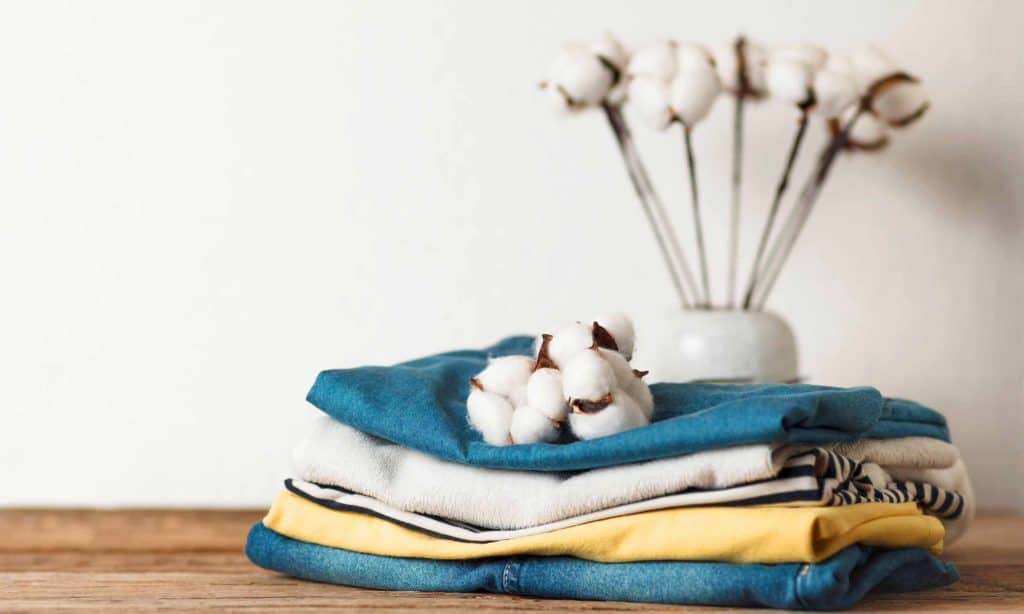As we mentioned earlier, one of the things we can do to sustain our wardrobe is to invest in good quality pieces that will last us longer. So, we don’t have to shop and spend money regularly. Investing in good quality clothes will prevent us from the pill, fade, and fall apart frustration after just one season. It’s time to shop smart and spot high-quality clothing when we’re shopping.
1. NATURAL FIBERS

The first thing I always pay attention to when I shop for new clothes is fabrics and materials. We know that the skin is our biggest organ, and it quite absorbs everything we put on it, even the chemicals used in clothing manufacture. From my experience, natural fabrics feel better on the skin and last longer, and are healthier choices if the material is organically made. The only exception I make is for activewear clothes. Due to their functional nature, they are usually made from synthetic materials. But, nowdays, there are improvements in that category and Lyocell/Tencel and SilverTech technology.
-Cotton
Cotton is one of my favorite fabrics for every day. I believe is the most affordable and the easiest one to take care of. A good quality organic cotton will feel soft, not scratchy. The longer the fibers of the cotton, the softer they’ll feel. Again, look at the labels, is it a blend with polyester or spandex or 100% cotton. Is always a better option if you can find 100% organic cotton.
-Cashmere
Good quality cashmere will feel super soft, almost like thick densely woven, the better ones are made of thinner fibers and with two-ply, comparing to one-ply, they are more likely to develop holes. To check the fabric’s strength, pull on it a little, a higher-quality cashmere will bounce back. Read the label, is it 100% cashmere or a blend? Is it woven tightly? Does it feel soft on your skin or a bit itchy?
-Linen
Linen is one of my favorites during summer days. Linen is made from the fiber of flax and is said to be 30% stronger than cotton. It’s one of the oldest fabrics known to man. Linen is strongest when wet and is also quite stain resistant. Best linen yarn comes from Ireland, Belgium, and France. This can be tricky when you shop in-store, but one way to check if you are holding real flex linen is, to drop a few drops of water on it and see the absorbency. The natural linen has such high moisture-wicking qualities, it absorbs water incredibly fast.
-Wool
Don’t get confused technically, cashmere is wool because it comes from an animal. When I say wool, I mean the other non-cashmere material used for sweaters and coats. Wool as a material is less delicate than cashmere, so already, it’s meant to last longer. There are different types and levels of wool and they all come from animals. The top quality wool will be merino wool, which will feel really fine. You’ll often see the names ‘Fine Merino Wool’ or ‘Ultrafine Merino Wool’ (the highest). Always check the label, is it a blend of 100% wool. The ones blend with cashmere are okay.
-Silk
The silk quality is determined by momme weight. The heavier the momme, the sturdier the fabric, and the higher the quality. But most brands won’t give up their momme weight, so you need to learn to judge silk by how it feels. For example, good quality silk will feel thick and heavy due to the sandwashed finish, which makes the fabric extra soft and almost suede-like. The fabric should be superfluid and if you drop it on your hand, you will see the outline of your fingers underneath.
2. THE CONSTRUCTION OF CLOTHES

The second thing you should look for in good quality clothing is the construction of it. How well the fabric pieces are stitched together. The first test you can do is hold the garment up to the light and stretch one of the seams to see how much light comes through. If the thread is really tight and even, this is a good sign. If the fabrics are a good match, check if your shirt has extra panels between shoulders, are there any bad stitches.
-Extra Buttons
If you noticed that your clothes came with extra buttons, it means the designer expects that piece of clothing to last longer with few repairs. And If you also come across a garment that includes spare thread, take that as a sign that you’ve found a quality item.
-Quality Button and Buttonholes
Cross-check all of the buttonholes for loose threads and if the hole size matches the button. You can define the button’s quality, whether it is made of plastic or metal, wood, or any other strong material. Are they sewn on well? You can check that by gently tugging on them. If any of the holes prove to be too small to accommodate the button, return the piece to the rack.
-Metal Zippers
If the clothing you are looking at has zippers, it is always better to go with a metal zipper than a plastic one. Plastic zippers are easily breakable and harder to zip and keep it zipped. The zippers should lie flat and be covered with a placket. And unless it’s part of the design, the stitching holding the zipper in place should match the material.
-Stitches and fabric seam
Hold the fabric on each side of a seam, and tug lightly to see how well the garment holds together. If you see any sign of pulling apart, it’s a sign that the stitches won’t last long. Check the stitches if there are any missed stitches, loose stitches, snags, crooked lines. If you notice any inconsistency in the stitches or something is hanging even a little bit, it is time to put it back on the shelf.
-Finished Seams
Look at the seams of any outfit you’re thinking of buying to make sure they lay flat and are free of puckers and other irregularities. Then, flip the piece inside out, and look at how the seams were finished. Unfinished edges are a sign of poor quality. Serged edges connote quality, but French seams, flat-felled seams, and bound seams are the true quality mark. Learn a bit about seams so that you can identify well-made pieces.
-Good Thread
A light thread is going very quickly to tear apart. So, have a good look at the thread. Does it appear to be strong enough to hold the fabric together? Are the stitches placed where they should be? I know at the beginning, it may be difficult to figure out what is good and what is a bad treat. But, over time, you will learn and sporting good quality clothes will become easier than ever.
3. MAINTAIN YOUR CLOTHES
Good quality clothes are an investment. If you take care of them, they’ll hold up for a very long time. Always read the washing instructions before throwing your clothes in the laundry machine, or even better, hand wash some of your delicate items. Learn how to fix small holes and sew new buttons.
– MOST COMMON MISCONCEPTIONS ABOUT THE QUALITY CLOTHES YOU SHOULD BE AWARE OF
1. The Higher the Price, the Higher the Quality
In general, higher prices do mean higher quality, but there are just as many other instances where more expensive items are only expensive because of brand perception and marketing. You can’t always judge the quality of an item with the price tag on it. Sometimes you will find yourself wearing that one shirt all over again for a long time and is still in good shape, and it was just 20$. Or opposite, you got that fancy shirt from X popular brand, just to realize that it didn’t last that long, which brings me to the next misconception.
2. Some Brands Are Always High Quality
Be careful about recognizing quality with certain brands in general. Every brand has its weaknesses and strengths. Many of us shop at certain brands because they are known for the good quality they have. Which it may be right, but for example, with J.Crew, sometimes you can find a good pair of jeans, but that’s not the case with the cashmere sweaters. In the end, while we are doing everything to be the best, we can all agree that no one is perfect, right?
3. All Fabrics Are Created Equal
Another misconception is when someone says cotton is cotton and linen is linen. For example, if you grab a 250$ cotton shirt, would that mean it will be the same quality as the one from 20$. Just because both labels are written 100% cotton doesn’t mean they have the same fabric quality.
There is so much behind that 100% cotton label, the sad part is most of the brands they don’t disclose all details. Only very few transparent brands will say exactly what grade of cotton is. So, again don’t let the label or price fool you. If you have an eye on some brand that you really love, study them before buying anything. Go to their website and read, if you have a store near you, walk in and go through different items, feel the products in your hand, and talk with the staff there, if you are lucky they may give you some insides.
I hope after this article you have a better idea of how to recognize good quality clothes and how to keep them for longer. If you have some more ideas, please let me know in the comment section below. If you like this post, feel free to pin the picture on your Pinterest board. It will mean a lot.








0 Comments
Trackbacks/Pingbacks